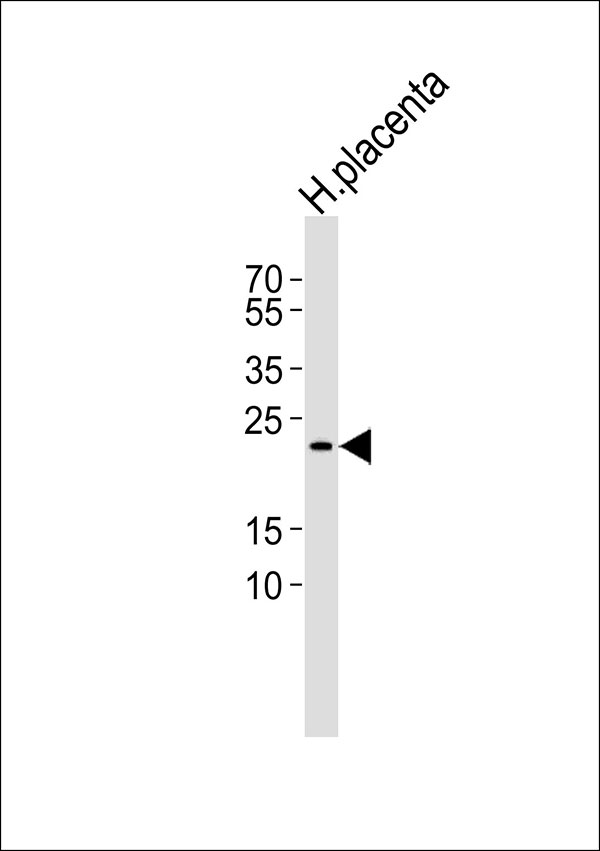DUSP22 Antibody
Purified Rabbit Polyclonal Antibody (Pab)
- SPECIFICATION
- CITATIONS
- PROTOCOLS
- BACKGROUND

Application
| WB |
|---|---|
| Primary Accession | Q9NRW4 |
| Reactivity | Human, Mouse |
| Host | Rabbit |
| Clonality | Polyclonal |
| Calculated MW | 21,23 KDa |
| Antigen Region | 125-153 aa |
| Gene ID | 56940 |
|---|---|
| Other Names | Dual specificity protein phosphatase 22, JNK-stimulatory phosphatase-1, JSP-1, Low molecular weight dual specificity phosphatase 2, LMW-DSP2, Mitogen-activated protein kinase phosphatase x, MAP kinase phosphatase x, MKP-x, DUSP22, JSP1, LMWDSP2, MKPX |
| Dilution | WB~~ 1:1000 |
| Format | Rabbit IgG in phosphate buffered saline (without Mg2+ and Ca2+), pH 7.4, 150mM NaCl, 0.09% (W/V) sodium azide and 50% glycerol. |
| Storage Conditions | -20℃ |
| Name | DUSP22 |
|---|---|
| Synonyms | JSP1, LMWDSP2, MKPX |
| Function | Dual specificity phosphatase; can dephosphorylate both phosphotyrosine and phosphoserine or phosphothreonine residues (PubMed:24714587, PubMed:38225265). Activates the JNK signaling pathway (PubMed:11717427). Inhibits T-cell receptor signaling and T-cell mediated immune responses, acting, at least in part, by inducing degradation of E3 ubiquitin ligase UBR2 (PubMed:24714587, PubMed:38225265). Dephosphorylates and thereby induces 'Lys-48'-linked ubiquitination of UBR2, leading to proteasomal degradation of UBR2 (PubMed:38225265). Dephosphorylates and thereby inactivates tyrosine kinase LCK (PubMed:24714587). Inhibits UBR2-mediated 'Lys-63'-linked ubiquitination of LCK (PubMed:38225265). May play a role in B-cell receptor (BCR) signaling and B-cell function (By similarity). |
| Cellular Location | Cytoplasm. |
| Tissue Location | Ubiquitous. Highest expression seen in heart, placenta, lung, liver, kidney and pancreas |

Thousands of laboratories across the world have published research that depended on the performance of antibodies from Abcepta to advance their research. Check out links to articles that cite our products in major peer-reviewed journals, organized by research category.
info@abcepta.com, and receive a free "I Love Antibodies" mug.
Provided below are standard protocols that you may find useful for product applications.
Background
Activates the Jnk signaling pathway. Dephosphorylates and deactivates p38 and stress-activated protein kinase/c-Jun N- terminal kinase (SAPK/JNK) (By similarity).
References
Shen Y.,et al.Proc. Natl. Acad. Sci. U.S.A. 98:13613-13618(2001).
Gu J.,et al.Submitted (JUL-1999) to the EMBL/GenBank/DDBJ databases.
Mao Y.,et al.Submitted (MAR-2003) to the EMBL/GenBank/DDBJ databases.
Ota T.,et al.Nat. Genet. 36:40-45(2004).
Mungall A.J.,et al.Nature 425:805-811(2003).
If you have used an Abcepta product and would like to share how it has performed, please click on the "Submit Review" button and provide the requested information. Our staff will examine and post your review and contact you if needed.
If you have any additional inquiries please email technical services at tech@abcepta.com.













 Foundational characteristics of cancer include proliferation, angiogenesis, migration, evasion of apoptosis, and cellular immortality. Find key markers for these cellular processes and antibodies to detect them.
Foundational characteristics of cancer include proliferation, angiogenesis, migration, evasion of apoptosis, and cellular immortality. Find key markers for these cellular processes and antibodies to detect them. The SUMOplot™ Analysis Program predicts and scores sumoylation sites in your protein. SUMOylation is a post-translational modification involved in various cellular processes, such as nuclear-cytosolic transport, transcriptional regulation, apoptosis, protein stability, response to stress, and progression through the cell cycle.
The SUMOplot™ Analysis Program predicts and scores sumoylation sites in your protein. SUMOylation is a post-translational modification involved in various cellular processes, such as nuclear-cytosolic transport, transcriptional regulation, apoptosis, protein stability, response to stress, and progression through the cell cycle. The Autophagy Receptor Motif Plotter predicts and scores autophagy receptor binding sites in your protein. Identifying proteins connected to this pathway is critical to understanding the role of autophagy in physiological as well as pathological processes such as development, differentiation, neurodegenerative diseases, stress, infection, and cancer.
The Autophagy Receptor Motif Plotter predicts and scores autophagy receptor binding sites in your protein. Identifying proteins connected to this pathway is critical to understanding the role of autophagy in physiological as well as pathological processes such as development, differentiation, neurodegenerative diseases, stress, infection, and cancer.


